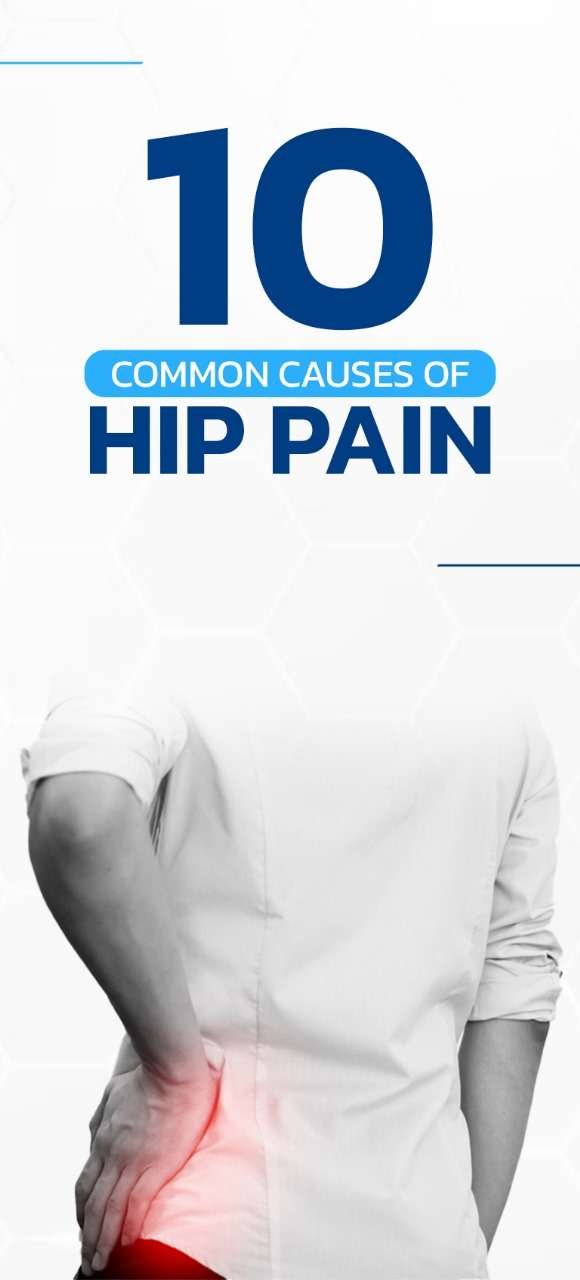

As a Joint Replacement Surgeon, I understand the distressing impact hip pain can have on your daily life. Hip pain is a prevalent complaint that affects people of all ages and lifestyles. Whether you’re an athlete, a busy professional, or a retiree enjoying leisurely activities, understanding the root causes of hip pain is crucial for effective management and treatment. In this blog, we’ll explore 10 common reasons why your hip might be hurting, shedding light on potential underlying issues and guiding you towards appropriate solutions.
Osteoarthritis, commonly known as wear-and-tear arthritis, is one of the leading causes of hip pain. It occurs when the protective cartilage that cushions the ends of your bones wears down over time, leading to pain, stiffness, and inflammation in the hip joint. Aging, genetics, obesity, and previous joint injuries are significant risk factors for developing osteoarthritis in the hip.
Hip bursitis refers to the inflammation of the bursae, small fluid-filled sacs that cushion the bones, tendons, and muscles near your hip joint. Repetitive activities, such as running or cycling, or sudden trauma can irritate the bursae, causing pain and tenderness in the outer hip area. Overuse, improper stretching, and structural abnormalities may contribute to the development of hip bursitis.
Tendinitis occurs when the tendons surrounding the hip joint become inflamed, often due to overuse or repetitive stress. Activities that involve repetitive motions, such as running, jumping, or climbing stairs, can strain the hip tendons, leading to pain and discomfort. Tight muscles, poor biomechanics, and inadequate warm-up routines may increase the risk of developing tendinitis in the hip.
Hip fractures, particularly common in older adults with osteoporosis, can cause sudden and severe hip pain. Falls, accidents, or direct trauma to the hip joint can result in a fracture of the femur (thigh bone) or the pelvic bone. Hip fractures require prompt medical attention and often necessitate surgical intervention to restore mobility and prevent complications.
The hip labrum is a ring of cartilage that lines the hip socket, providing stability and cushioning to the joint. Labral tears can occur due to injury, structural abnormalities, or degenerative changes in the hip joint. Activities that involve twisting, pivoting, or sudden changes in direction, such as sports or dancing, can increase the risk of labral tears and lead to hip pain, stiffness, and decreased range of motion.
Hip dysplasia is a congenital condition characterized by abnormal development of the hip joint, leading to instability, malalignment, and premature wear and tear of the hip cartilage. While hip dysplasia is often diagnosed in infancy or childhood, milder forms may go unnoticed until adulthood, presenting as hip pain, stiffness, and decreased mobility. Genetic factors and intrauterine positioning can contribute to the development of hip dysplasia.

Muscle strains, or pulled muscles, occur when the muscles surrounding the hip joint are stretched or torn beyond their limits. Overexertion, sudden movements, or inadequate warm-up can strain the hip muscles, causing pain, swelling, and limited mobility. Weakness, imbalances, and poor flexibility in the hip muscles may predispose individuals to muscle strains and other injuries.
Sciatica refers to the compression or irritation of the sciatic nerve, which runs from the lower back through the hips and down the legs. Herniated discs, spinal stenosis, or muscle imbalances can exert pressure on the sciatic nerve, resulting in radiating pain, tingling, or numbness along the hip and leg. Prolonged sitting, lifting heavy objects, or poor posture can exacerbate sciatic symptoms and aggravate hip pain.
Inflammatory conditions, such as rheumatoid arthritis or ankylosing spondylitis, can affect the hip joint, causing chronic inflammation, pain, and stiffness. Autoimmune disorders that target the synovium (the lining of the joint) or the surrounding tissues can lead to progressive joint damage and functional impairment. Early diagnosis and appropriate management are essential for controlling inflammation and preserving joint function in inflammatory hip conditions.
Overuse injuries, resulting from repetitive stress or excessive training, can strain the muscles, tendons, and ligaments around the hip joint. Runners, cyclists, and athletes involved in high-impact sports are particularly susceptible to overuse injuries, such as stress fractures, IT band syndrome, or hip flexor strain. Proper training techniques, adequate rest, and gradual progression are essential for preventing overuse injuries and maintaining hip health.
Hip pain has various causes, from degenerative conditions to overuse injuries. If you’re experiencing persistent or worsening discomfort, seek evaluation from a Hip Replacement Surgeon for personalized treatment. With timely intervention, management strategies, and lifestyle changes, you can improve mobility and regain control over daily activities. Understanding the root cause is crucial for lasting relief and optimal joint health. To get rid of Hip Pain, consult Dr. Bakul Arora at Arora Clinic.
WhatsApp us